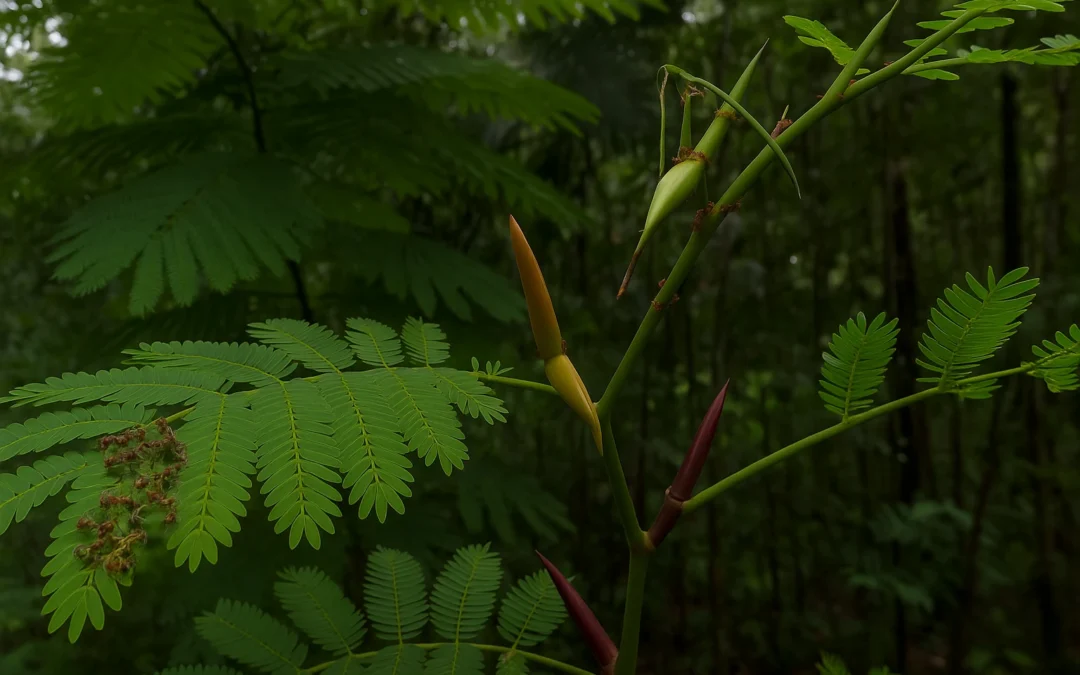The Tree and Its Guardians
In the tropical rainforest of the Osa Peninsula, every leaf, root, and creature tells a story of balance. Yet few are as extraordinary as that of Vachellia allenii, known locally as the bullhorn acacia or cornizuelo, and its tireless protectors — the Pseudomyrmex ants.
At first glance, this thorny tree might seem like an ordinary shrub of the tropical forest. But a closer look reveals an entire microcosm of life: tiny ants patrolling every branch, defending their territory, and living inside the hollow thorns that the tree itself provides as shelter.
The relationship between Vachellia allenii and Pseudomyrmex ants is one of the most fascinating examples of mutualism in nature — a partnership where both species completely depend on each other to survive.
The tree offers housing and food: its horn-shaped thorns serve as nests, while its leaves produce nectar and Beltian bodies, small protein-rich structures made exclusively to feed the ants. In return, the ants protect the tree with military precision — they attack herbivorous insects, remove competing seedlings, and even cut vines that threaten to block sunlight.
This cooperation is so specialized that the ants cannot live without the tree, and the tree loses its defense without the ants. In other words, one cannot exist without the other — a perfect alliance that maintains the rainforest’s invisible balance.
A Living Symbol of Natural Balance
In places like Corcovado, Los Planes, and the surroundings of Piedras Blancas, this relationship can be observed in its purest form. During a guided hike, a gentle touch on a branch is enough to see the ants emerge instantly, alert and organized, ready to defend their home.
Far from being aggressive without reason, their behavior reflects the deep intelligence of nature — defense, harmony, and cooperation in perfect equilibrium.
For our naturalist guides, the story of the bullhorn acacia is a living lesson on how interdependence sustains life. While visitors marvel at monkeys, macaws, or tapirs, these small guardians work silently, ensuring that the forest continues to thrive.
A Unique Treasure of the Osa Peninsula
The species Vachellia allenii is found only in the central and southern Pacific regions of Costa Rica, with its greatest abundance in the Osa Peninsula. It can grow up to 18 meters tall, with a trunk and branches covered in hollow, horn-shaped spines — a striking feature that makes it unmistakable in the forest landscape.
This tree is listed as Endangered (EN), which makes every encounter with it a privilege. To see it in its natural habitat, surrounded by its loyal ants, is to witness the rainforest’s resilience and the precision of nature’s design.
The best way to appreciate this remarkable relationship is on a guided nature walk through open, sunny areas of the forest where the acacia grows naturally. Our guides will help you recognize the hollow thorns, the small entry holes used by the ants, and the delicate harmony between these two species.
💡 Guide’s Tip: Avoid touching the tree — the ants react quickly to defend it. Observe quietly, breathe in the forest air, and let nature reveal its wisdom.
The story of Vachellia allenii and its guardian ants is a perfect metaphor for the rainforest itself: every living being, no matter how small, plays a vital role in the ecosystem’s balance.
Exploring the Osa Peninsula is far more than an adventure — it’s an opportunity to understand how cooperation sustains life and to feel part of nature’s living web.
👉 Discover this and other secrets of the rainforest with Osa Outdoors Adventures — your journey into the heart of nature begins here.


